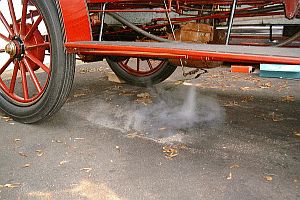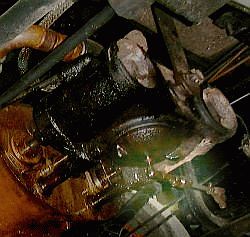A good practice during firing up is to
open the throttle and the drip valve. Once the burner is burning kerosene,
the burner valve should be opened a small amount (perhaps one-quarter to
one-third of a turn of the valve wheel) so that the burner doesn’t fire at
maximum heat. While this means the firing up process takes longer, it is
better for the car since the boiler and the superheater are not subjected to
extreme heat but rather are heated gradually. From when the car was shut
down there will no doubt be water condensed in the superheater which will
turn to steam and vent out the drip valve.
Once the water of the boiler starts
boiling the generated steam will be released through the throttle. The steam
will blow any water in the engine steam lines back to the engine and out the
drip valve at the bottom of the valve chest. At this point the burner valve
can be opened fully and the burner fired at its maximum rate. The steam
running through the superheater acts to cool the superheater and thus
protects the superheater from damage.
 The steam flow has the added benefit
that it serves to heat the engine valve chest and cylinders as it exits the
drip valve under the engine. To protect the superheater keep a small amount
of steam passing through the line, which is enough moisture to protect the
superheater. As the burner heats the boiler and steam generation increases,
the throttle will need to be closed to only allow a low rate of steam flow
from the drip valve. Steam pressure will increase and as it does the
throttle will need to be continually adjusted to close down the steam flow.
Proper steam flow through the drip should be such that the exiting steam
just hits the pavement under the car rather than floods the pavement under
the car with an inverted mushroom cloud of steam. Shown at the left is
a 1908 Model K Stanley being fired up. The steam flow cascading from
the drip is nominal for keeping the superheater properly cooled and for
preheating the engine casting.
The steam flow has the added benefit
that it serves to heat the engine valve chest and cylinders as it exits the
drip valve under the engine. To protect the superheater keep a small amount
of steam passing through the line, which is enough moisture to protect the
superheater. As the burner heats the boiler and steam generation increases,
the throttle will need to be closed to only allow a low rate of steam flow
from the drip valve. Steam pressure will increase and as it does the
throttle will need to be continually adjusted to close down the steam flow.
Proper steam flow through the drip should be such that the exiting steam
just hits the pavement under the car rather than floods the pavement under
the car with an inverted mushroom cloud of steam. Shown at the left is
a 1908 Model K Stanley being fired up. The steam flow cascading from
the drip is nominal for keeping the superheater properly cooled and for
preheating the engine casting.
The second and perhaps most important
use of the cylinder drain valve is to provide a means for water to escape
from the steam lines and engine valve chest when starting the car out from
rest. When the car is stopped there will be some residual steam in the
piping past the throttle. Anytime the car sits idle for a short period of
time this steam will condense back to water. Additionally if the throttle
leaks, the steam will flow into the superheater and piping to the engine.
With the burner off these pipes eventually cool and the condensing water may
eventually fill the superheater and engine steam piping with water. This
water will collect in the superheater and piping to the engine.
When it is time to move the car again,
opening the throttle will cause all this water will be blown back to the
engine. If the drip valve is closed the water will be blown into the engine
cylinders where clearances at either end of the piston stroke to the
cylinder heads are tight. Too much water, which is non-compressible, and
cylinder heads will be blown off and the piston shafts and crank arms can be
bent. Opening the drip, along with always starting out slowly allows any
accumulated water to exit the drip valve and not enter the cylinders. In
fact a good practice especially when steaming up the car is to "rock" it
back and forth. This relieves any water trapped in the engine cylinders.
Rocking the car can be accomplished by moving 10 feet forward or so,
stopping, then reversing back to the starting position. This should be done
slowly where there is between 400 PSIG and 500 PSIG steam
pressure and with the drip valve one-half turn open.
Generally for a car in good condition,
where a strong pilot is maintained, there is little necessity for operating
the burner for any length of time to build steam pressure before starting
out after the car has been parked for awhile. Thus there’s little chance of
damage to the superheater. Still, a good practice if steam pressure has to
be raised after parking for car for several hours is to open the drip and
allow steam-flow to cool the superheater while preheating the engine. When
starting out, or any time there is reason to believe condensation might have
accumulated in the cylinders and piping, the drip should be left open when
starting out. The drip should be left open one quarter to one half a turn to
allow water and steam to blow free. When the water no longer exits the drip
it may be closed. Opening the drip too much allows too much steam to escape
to the point that there’s not enough steam pressure for the engine to move.
When used too long or too often, having the drip valve open too much can be
detrimental as the high steam flow cleans out the saturation of cylinder oil
from the steam line.

 The steam flow has the added benefit
that it serves to heat the engine valve chest and cylinders as it exits the
drip valve under the engine. To protect the superheater keep a small amount
of steam passing through the line, which is enough moisture to protect the
superheater. As the burner heats the boiler and steam generation increases,
the throttle will need to be closed to only allow a low rate of steam flow
from the drip valve. Steam pressure will increase and as it does the
throttle will need to be continually adjusted to close down the steam flow.
Proper steam flow through the drip should be such that the exiting steam
just hits the pavement under the car rather than floods the pavement under
the car with an inverted mushroom cloud of steam. Shown at the left is
a 1908 Model K Stanley being fired up. The steam flow cascading from
the drip is nominal for keeping the superheater properly cooled and for
preheating the engine casting.
The steam flow has the added benefit
that it serves to heat the engine valve chest and cylinders as it exits the
drip valve under the engine. To protect the superheater keep a small amount
of steam passing through the line, which is enough moisture to protect the
superheater. As the burner heats the boiler and steam generation increases,
the throttle will need to be closed to only allow a low rate of steam flow
from the drip valve. Steam pressure will increase and as it does the
throttle will need to be continually adjusted to close down the steam flow.
Proper steam flow through the drip should be such that the exiting steam
just hits the pavement under the car rather than floods the pavement under
the car with an inverted mushroom cloud of steam. Shown at the left is
a 1908 Model K Stanley being fired up. The steam flow cascading from
the drip is nominal for keeping the superheater properly cooled and for
preheating the engine casting.